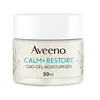What's inside
What's inside
 Key Ingredients
Key Ingredients

 Benefits
Benefits

 Concerns
Concerns

No concerns
 Ingredients Side-by-side
Ingredients Side-by-side

Water
Skin ConditioningGlycerin
HumectantCaprylic/Capric Triglyceride
MaskingDipropylheptyl Carbonate
EmollientSqualane
EmollientSodium Polyacrylate
AbsorbentHydrolyzed Yeast Protein
Skin ConditioningButylene Glycol
HumectantPentylene Glycol
Skin ConditioningNiacinamide
SmoothingPhenoxyethanol
PreservativeSodium Hyaluronate
HumectantPolysorbate 20
EmulsifyingXanthan Gum
EmulsifyingAloe Barbadensis Leaf Juice
Skin ConditioningPanthenol
Skin ConditioningPalmitoyl Tripeptide-1
Skin ConditioningPalmitoyl Tetrapeptide-7
Skin ConditioningCeramide NP
Skin ConditioningCeramide AP
Skin ConditioningCeramide EOP
Skin ConditioningPhytosphingosine
Skin ConditioningCholesterol
EmollientSodium Lauroyl Lactylate
EmulsifyingCarbomer
Emulsion StabilisingEthylhexylglycerin
Skin ConditioningWater, Glycerin, Caprylic/Capric Triglyceride, Dipropylheptyl Carbonate, Squalane, Sodium Polyacrylate, Hydrolyzed Yeast Protein, Butylene Glycol, Pentylene Glycol, Niacinamide, Phenoxyethanol, Sodium Hyaluronate, Polysorbate 20, Xanthan Gum, Aloe Barbadensis Leaf Juice, Panthenol, Palmitoyl Tripeptide-1, Palmitoyl Tetrapeptide-7, Ceramide NP, Ceramide AP, Ceramide EOP, Phytosphingosine, Cholesterol, Sodium Lauroyl Lactylate, Carbomer, Ethylhexylglycerin
Water
Skin ConditioningGlycerin
HumectantDimethicone
EmollientCetearyl Olivate
Avena Sativa Kernel Flour
AbrasiveAvena Sativa Kernel Extract
AbrasiveChrysanthemum Parthenium Flower/Leaf/Stem Juice
AntioxidantEthylhexylglycerin
Skin ConditioningPentylene Glycol
Skin ConditioningC13-14 Isoparaffin
EmollientPolyacrylamide
Dimethiconol
EmollientSorbitan Olivate
EmulsifyingSynthetic Beeswax
Emulsion StabilisingLaureth-7
EmulsifyingDimethicone Crosspolymer
Emulsion StabilisingCarbomer
Emulsion StabilisingSodium Hydroxide
BufferingCitric Acid
BufferingSodium Metabisulfite
AntioxidantBHT
AntioxidantPhenoxyethanol
PreservativeChlorphenesin
AntimicrobialSodium Benzoate
MaskingPotassium Sorbate
PreservativeWater, Glycerin, Dimethicone, Cetearyl Olivate, Avena Sativa Kernel Flour, Avena Sativa Kernel Extract, Chrysanthemum Parthenium Flower/Leaf/Stem Juice, Ethylhexylglycerin, Pentylene Glycol, C13-14 Isoparaffin, Polyacrylamide, Dimethiconol, Sorbitan Olivate, Synthetic Beeswax, Laureth-7, Dimethicone Crosspolymer, Carbomer, Sodium Hydroxide, Citric Acid, Sodium Metabisulfite, BHT, Phenoxyethanol, Chlorphenesin, Sodium Benzoate, Potassium Sorbate
 Reviews
Reviews

Ingredients Explained
These ingredients are found in both products.
Ingredients higher up in an ingredient list are typically present in a larger amount.
Carbomer is a polymer of acrylic acid. Its main role is to create a gel consistency.
A high amount of carbomer can cause pilling or balling up of products. Don't worry, most products contain 1% or less of carbomer.
Ethylhexylglycerin (we can't pronounce this either) is commonly used as a preservative and skin softener. It is derived from glyceryl.
You might see Ethylhexylglycerin often paired with other preservatives such as phenoxyethanol. Ethylhexylglycerin has been found to increase the effectiveness of these other preservatives.
Glycerin is already naturally found in your skin. It helps moisturize and protect your skin.
A study from 2016 found glycerin to be more effective as a humectant than AHAs and hyaluronic acid.
As a humectant, it helps the skin stay hydrated by pulling moisture to your skin. The low molecular weight of glycerin allows it to pull moisture into the deeper layers of your skin.
Hydrated skin improves your skin barrier; Your skin barrier helps protect against irritants and bacteria.
Glycerin has also been found to have antimicrobial and antiviral properties. Due to these properties, glycerin is often used in wound and burn treatments.
In cosmetics, glycerin is usually derived from plants such as soybean or palm. However, it can also be sourced from animals, such as tallow or animal fat.
This ingredient is organic, colorless, odorless, and non-toxic.
Glycerin is the name for this ingredient in American English. British English uses Glycerol/Glycerine.
Learn more about GlycerinPentylene glycol is typically used within a product to thicken it. It also adds a smooth, soft, and moisturizing feel to the product. It is naturally found in plants such as sugar beets.
The hydrophilic trait of Pentylene Glycol makes it a humectant. As a humectant, Pentylene Glycol helps draw moisture from the air to your skin. This can help keep your skin hydrated.
This property also makes Pentylene Glycol a great texture enhancer. It can also help thicken or stabilize a product.
Pentylene Glycol also acts as a mild preservative and helps to keep a product microbe-free.
Some people may experience mild eye and skin irritation from Pentylene Glycol. We always recommend speaking with a professional about using this ingredient in your routine.
Pentylene Glycol has a low molecular weight and is part of the 1,2-glycol family.
Learn more about Pentylene GlycolPhenoxyethanol is a preservative that has germicide, antimicrobial, and aromatic properties. Studies show that phenoxyethanol can prevent microbial growth. By itself, it has a scent that is similar to that of a rose.
It's often used in formulations along with Caprylyl Glycol to preserve the shelf life of products.
Water. It's the most common cosmetic ingredient of all. You'll usually see it at the top of ingredient lists, meaning that it makes up the largest part of the product.
So why is it so popular? Water most often acts as a solvent - this means that it helps dissolve other ingredients into the formulation.
You'll also recognize water as that liquid we all need to stay alive. If you see this, drink a glass of water. Stay hydrated!
Learn more about Water